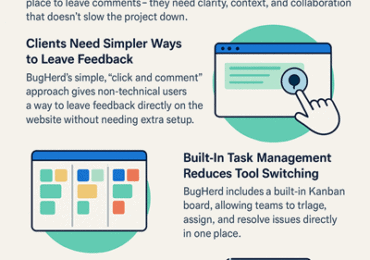Not every feedback tool fits every team. As web projects get more complex and clients become more involved in the review process, developers and agencies are realizing they need more than just a place to leave comments—they need clarity, context, and collaboration that doesn’t slow the project down.
Marker.io has been a popular option for collecting website feedback, but lately, more teams are making the switch to BugHerd. It’s not about which tool is better on paper—it’s about which one solves the real-world friction that comes with working on websites in a fast-paced, collaborative environment.
So, what’s prompting the move?
Clients Need Simpler Ways to Leave Feedback
One of the first pain points agencies mention is client onboarding. While Marker.io works well for internal QA or teams who are comfortable with browser extensions and integrations, some clients aren’t as tech-savvy. BugHerd’s simple, “click and comment” approach gives non-technical users a way to leave feedback directly on the website without needing extra setup.
The feedback pins appear visually on the live site, making it clear what needs to be changed—and avoiding the confusion of vague email descriptions like “the second button under the thing on the left is broken.”
This ease of use can speed up approvals, reduce back-and-forth, and improve the overall experience for clients who aren’t used to digital project workflows.
Built-In Task Management Reduces Tool Switching
Another reason for the shift is BugHerd’s integrated task board. While Marker.io sends feedback into external tools like Trello, Jira, or Asana (which BugHerd also supports), not every team wants to rely entirely on outside platforms for managing tasks.
BugHerd includes a built-in Kanban board, allowing teams to triage, assign, and resolve issues directly in one place. It’s especially helpful for smaller teams or freelance developers who don’t want to overcomplicate their tool stack.
With all feedback tied to tasks and statuses, developers can instantly see what’s pending, in progress, or done—without digging through other apps or manually updating spreadsheets.
Visual Context Saves Time on Reproduction
For developers, clarity is everything. A screenshot is helpful, but what really matters is understanding why the issue happened. BugHerd automatically captures context like browser type, screen size, operating system, and console logs with every submitted item.
This makes it much easier for devs to reproduce bugs and understand environmental factors that may be contributing to the issue—especially when those issues only appear under specific conditions.
While Marker.io also collects metadata, users often point to BugHerd’s cleaner organization and visibility into that data as a time-saver.
Video Feedback: A Game-Changer for Dynamic Issues
Text and screenshots aren’t always enough—especially when dealing with animation glitches, interactive UI bugs, or weird edge cases that only happen when you click things in a certain order. That’s why video feedback is becoming more valuable in web QA.
BugHerd includes built-in video feedback capabilities, letting users record short clips directly within the tool. Reviewers can walk through the issue visually, making it much easier for developers to understand what’s going wrong without needing a Zoom call or screen-share.
This feature has been a game-changer for teams juggling feedback from multiple stakeholders across different time zones.
Collaboration Across Teams and Clients
For agencies, collaboration isn’t limited to the dev team. Project managers, designers, copywriters, and clients all have input on what the final product should look like. BugHerd makes it easy to invite collaborators, tag team members, and comment on tasks without the need for extra accounts or complicated permissions.
This collaborative flexibility has become a deciding factor for many teams looking at marker.io alternatives. It’s not just about collecting feedback—it’s about moving that feedback through the entire lifecycle of a project.
Better for Agencies Managing Multiple Projects
Agencies often manage multiple client sites at once, each with its own stakeholders, deadlines, and quirks. BugHerd makes it simple to organize feedback by project, so everything stays clean and contained. You’re not sorting through feedback from one site while working on another, and you can customize access per client or team member.
This structure helps agencies scale their workflows without overwhelming their developers—or their clients.
Final Thoughts
Marker.io has served many teams well, but the growing shift toward BugHerd comes down to usability, efficiency, and better alignment with how modern web teams operate. Developers want clearer feedback. Project managers want smoother collaboration. Clients want to be involved without needing to learn new tools.
BugHerd brings those needs together in a way that’s both straightforward and flexible, making it one of the most practical marker.io alternatives for 2025 and beyond.
At the end of the day, the best tool is the one that removes friction, keeps your projects moving, and leaves everyone—developers and clients alike—with fewer headaches.
